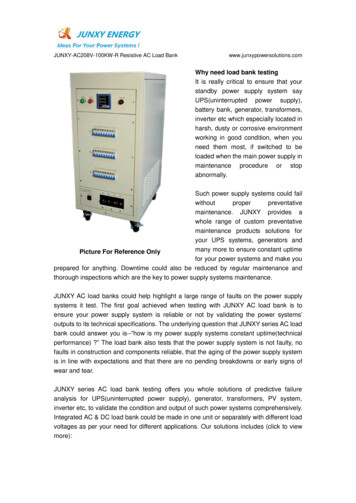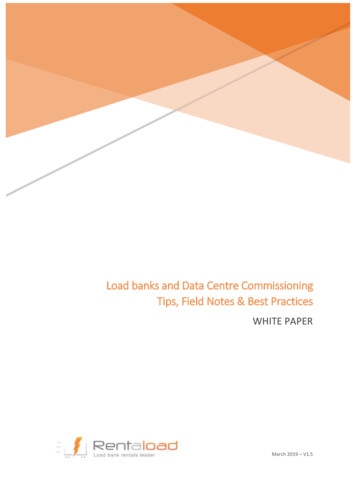
Transcription
White PaperLoad Bank Testing toEnsure Generator Set Performance
Photo courtesy of ASCO Power TechnologiesDiesel Engine Generator sets (gensets), are one of the main components in Emergency Backup Power Systems. Theirfailure to perform in an Emergency situation could result in catastrophic conditions. The main goal of load bank testingis to uncover potential genset problems in a controlled situation, rather than during an actual power failure. Load banktesting therefore is a critical part of a genset maintenance program.In the case of a standby diesel genset, a load bank test will indicate: The engine’s ability to provide the required poweroutput (kW) Voltage regulator response time The alternator’s capability to provide requiredvoltage, and frequency stability The genset control system under varyingconditions of load General performance of the whole system, oil andfuel pressure A load bank test will also help remove fuel depositsfrom pistons, engine castings and exhaust With data logging software load test results can berecorded and the technician can analyze workthat needs to be doneThe Case for Load Bank TestingAs detailed below, load banktesting is the best practicalmeans to ensure efficientoperation of a genset. Be itjust purely resistive or resistive and inductive any loadtest is far superior then noload testing or using uncontrollable building loads.Load banks can help testand improve the health ofgenerator and its components in the following ways:1Voltage Regulator2Governor Operation3Cooling System4Fuel System5Control Operation32514A typical diesel generatorarrangement.
Load Bank Testing to Verify Voltage Regulator OperationThe voltage regulator is a critical component of the genset as it allows the system to recover quickly from large loadchanges. Only resistive and inductive load bank testing can verify the performance of the genset voltage regulator; theoperation of the regulator is not fully assessed in a resistive-only load bank test. When large loads are applied, enginespeed drops, before shortly recovering to its steady-state condition. This recovery interval is known as the “transientresponse.” If the regulator(s) are not functioning properly, recovery may not be possible. In some extreme cases, thegenerator magnetic field will collapse, rendering the generator useless. Testing with a resistive/inductive load bankpermits loads to be introduced that have the same characteristics as actual “real world” loads. Automatic transientresponse tests can be configured by sophisticated load bank control systems to verify voltage regulator operation.Load Bank Testing to Verify Governor OperationGovernors are devices that monitor, limit and determine engine speed under various conditions. There are three (3)main types of governors: velocity, mechanical and electrical. Velocity Governors: Are designed to run on a vacuum, and mount between the carburetor and the intakemanifold. These governors limit the maximum RPM of an engine, and as such act as a protective device. Mechanical Governors: Will not only limit top speed (as do velocity governors) they will also allow theengine to react while under a sudden load. Electronic Governors: Pick up the engine speed from the flywheel ring gear’s teeth and control it electronically.No matter what type of governor, all genset engine governors respond to loading by reducing engine speed. The resultinginitial voltage drop using 75% load at 0.80 power factor results in a voltage drop that is approximately 25% greater whencompared to the equivalent resistive only load application. The engine speed related voltage drop is also similar.Load Bank Testing to Verify Cooling System OperationA load test causes the generator to inject additional heat into the cooling air stream, which will highlight any weaknessin the cooling system. This additional heat will also stress major cooling system components like radiator, oil coolerand thermostat. The collection of genset heat data from a load bank testing will also help determine the temperaturedifferential (Delta T). This temperature data can be used to verify genset compliance or as another data point fortroubleshooting any system air restrictions. Load testing will also verify the operations of cooling system alarms likethe engine coolant overheat, and high cooling water temperature alarm.
Photo courtesy of ASCO Power TechnologiesLoad Bank Testing to Verify Fuel System OperationModern diesel engines are typically highly turbocharged, and are prone to over fueling and poor combustion at lowloads. Unless the engine is run at a load high enough to generate high exhaust temperatures and flow velocities, thedeposits will coat engine exhaust surfaces including turbo turbine wheels, exhaust piping, mufflers/silencers, andinstalled exhaust after treatment systems. Initially this is only a nuisance, however allowed to build up, it will affectengine performance (turbo does not spin up as it should because of debris on the hot wheel), and allowed to go onfurther will generate a fire hazard by building up combustible debris in the exhaust system.Wet Stacking: Diesel-driven units are subject to the condition above which is known as “wet stacking”. Wet Stackingoccurs from operation under no-load or light-load conditions. Operation in an unloaded condition (such as extendedidle time) or continual use at less than the recommended minimum load level causes fuel deposits to collect on thecombustion chamber, injector nozzles, piston rings, turbocharger, and exhaust system. The result is diminished engineoutput capacity. Regular load bank testing burns off accumulated deposits and preserves engine output capability.The amount of minimum load varies per engine manufacturer, but the typical range is 30% to 50% of the kilowattrating. It is also a proven fact that diesel engines operate more efficiently in the 70% to 80% range of rated kW output.Load testing will also help identify any potential failures resulting from plugged fuel filters, fuel/injection pump, fueloverheating and cooler operation.Load Bank Testing to Verify Control OperationGenset solid-state controls and power supplies are particularly sensitive to transients and can shut down unexpectedly during load changes. Some modern gensets are backed up with a dedicated power source capable of ridingthrough the voltage and frequency transients associated with loading. However, the basic fact remains that a resistiveand inductive load test provides the best means to ensure proper generator operation. Many control and electricalissue like circuit breaker trip settings, voltage and frequency adjustments, voltage regulator performance and looseor failed connections can be uncovered during a load test procedure. Resistive and inductive load bank testing provides a best-case simulated real-world condition where voltage-drop, harmonics, and efficiency can be analyzed moreeffectively. Testing with a resistive-only load bank, a system would not necessarily provide an indication of a powersupply or control system condition that would lead to a potential problem during operation.
Resistive vs Resistive Inductive Load TestingSome load banks contain resistive elements only and therefore cannot provide a true simulation of the loading that thegenset will be subjected to in actual service. Most gensets are rated in kW at a specified power factor (for example,1000 kW at 0.8 PF). These ratings reflect the actual load conditions that the unit will be called upon to satisfy.A resistive only load test will confirm the engine’s ability to provide kW, and the generator’s ability to deliver an equivalent (equal) amount of kVA. A resistive only test will not “stress” the generator through actual operating conditions. Inreality, only engine performance is validated in a resistive-only test.With a resistive/Inductive loadbank, inductive and resistive aredesigned to yield a total value ofimpedance that exposes the engine and generator to the loading that they will experience inactual service. Testing at generator nameplate values requiresa resistive/inductive load bank.The critical differences betweentesting with a resistive-only loadbank and a resistive/inductiveload bank are compared in Table1. A resistive-only load bank canprovide adequate testing of theindividual prime mover and loadsharing (including load add/loadshed) controls of a multiple unitfacility.The ability to simulate varyinginductive loads, which are morerealistic, is the most essentialbenefit for a load bank thatprovides both kVA (resistive)and kVAR (inductive) loads.Combined resistive and inductive load bank allows testing ofthe alternator, load sharing, andtransient responses because itapply loads that approach thoseexperienced during normalgenset operation (see Table 2).Resistive Only and Resistive/Inductive Load Bank Testing ComparisonResistive Load Bank TestingkW kVA at unity power factorResistive/Inductive Load Bank TestingInductive power componentTests the prime mover (engine) at 100% loadTests the alternator and voltage regulator atits fully rated (kVA/kVAR) capacityTests the full delivery system operation atmaximum rating and fuel consumptionSimulates the actual load (kW, kVA, and kVAR)for which the systems are specified and designedDemonstrates the cooling system operationat the gensets full operating capacitySimulates transient loads to provide voltageand frequency response characteristicsAllows the exhaust and after-treatment systemto reach normal operating temperaturesSimulates and verifies synchronizing, load sharing,and voltage regulation on multiple unit paralleledsystems under actual load conditionsEliminates exhaust wet-stacking by burning offbuilt-up carbon deposits from unburned fuel and oil,and reseats the rings when partial- or low-loadconditions are encountered during periodic testingAllows thermographic/infrared inspection of theelectrical systems; identification of potential hotspots; and the condition of cables, terminationsand buss workEvaporates moisture from the engine oil, whichreduces wear-causing acid formationIdentifies deficiencies that can be corrected withproper maintenance and repair before failure,avoiding downtime and additional expensesResistive and Resistive/Inductive Load Bank ComparisonCharacteristicsResistiveLoad BankResistive/InductiveLoad BankPrime Mover Capacity (kW)YesYesPrime Mover ControlsYesYesAlternator Capacity (kVAR)LimitedFull LoadAlternator ControlsLimitedYesLoad Sharing ControlskW onlykW and kVARDistribution BussLimitedFull LoadTransient Response (Hz)YesYesTransient Response (Voltage)LimitedYesTable 1 (above) andTable 2 (left)Resource data fortable from “ConsultingSpecifying Engineer”(www.csemag.com)11-12-2013 article.
A Round-Up of Code RequirementsIn most cases, emergency power generating systems must comply with a number of different code requirementsbased on National Fire Protection Association (NFPA) 110, Joint Commission, Environmental Protection Agency (EPA)Tier regulations, and National Electrical Code (NEC) specifications. Here is a rundown of the major industry standardsand codes that cover emergency power generation and testing.NFPA 110 Emergency Generator Testing Requirements sets safety standards to protect commercial buildingoccupants by making sure generator-powered backup lighting will operate as expected. A monthly test is performedon generators whose failure could result in death or injury. Should a generator fail this monthly test, it should undergoload bank testing for two continuous hours annually, per Section 8.2.4.3. It is not mandatory to use load banks, butmost buildings’ total load values are below the higher monthly testing requirements. Under the continuous test, thegenerator should be operated at 25 percent of the nameplate kilowatt rating for 30 minutes, at 50 percent of thekilowatt rating for 30 minutes and at 75 percent of the kilowatt rating for 60 minutes.NEC 700 Emergency Systems are legally required to receive an operating permit as determined by the local codeenforcement authority. This electrical code requirement is essentially a people-oriented lifeline, ensuring that lightingand controls for occupant life safety loads take priority over other building loads. Should the main electrical powersupply fail, backup emergency power for life safety systems must be available within 10 seconds.NEC 701 Legally Required Standby Systems are the next priority, after NEC 700. NEC 701 requires standby powerto be available in 60 seconds or less after a power loss to certain legally required standby systems. Basically, NEC700 is designed for people who are exiting the building, while NEC 701 responds to the needs of firefighters and otherpersonnel responding to the emergency.NEC 702 Optional Standby Systems apply to situations where standby generators are optional. In these cases, thesystems may be put in place to protect economic loss or business interruptions. For instance, data centers may losemillions of dollars from lost power.NEC 708 Critical Operations Power Systems (COPS) came into being through the U.S. Department of HomelandSecurity after 9-11, Hurricanes Katrina and Rita, and other disasters. This code requires a commissioning planfor on-site backup generation, baseline testing, and periodic witness testing, as well as a documented preventivemaintenance program, written records of testing, and the way for testing all critical power systems during maximumanticipated load conditions.
Joint Commission requirements encourage hospitals, health centers, and nursing homes to go beyond local, state,and national electrical codes, thereby ensuring that emergency power systems provide patient safety and preventloss of life. Periodic testing is required for all healthcare facilities, preferably under higher loads than the 30 percentminimum. At least once every three years, all healthcare facilities are required to exercise the power system under thefacility’s actual load and full emergency conditions for at least four hours.In 2014, the Joint Commission announced changes to monthly generator load testing, permitting it to be done anytimeduring the month, rather than the previous requirement of no less than 20 days and no more than 40 days from theprevious monthly load test.EPA Tier Level regulations apply to emissions from modern diesel generators, when operated at loads of more than50 percent. Using load banks allows for simultaneously testing multiple units, thereby reducing the time required toperform and document mandatory testing to ensure the electronic engine and emissions controls are operating at themanufacturer’s recommended load levels and temperatures.ISO 8528 applies to test methods and criteria for measuring the alternating current of generation sets that aredriven by reciprocating internal combustion engines in load bank testing. In part 6 of the standard, three performanceclasses, Grade 1, Grade 2 and Grade 3 are defined, along with their associated performance criteria. A fourth class,Grade 4, also is available but applies to customized performance criteria determined by the supplier and the customer.Grade 2 is the normal grade specified.SummaryWith emergency generator sets becoming more mandated and commonplace, proper load bank testing becomes muchmore important. Selecting the proper type of load bank, be it either 100% resistive or combined resistive and inductive iscritical for performance testing and troubleshooting of the genset.
ASCO Power Technologies Avtron6255 Halle DriveCleveland, OH 44125Tel: 216.573.7600LBsales@vertivco.comASCO Power Technologies NJ Froment & Co. LtdEaston-on-the-HillStamford, PE9 3NPUnited KingdomTel: 44 1780 r.comcustomercare@ascopower.comThe ASCO and ASCO Power Technologies marks are owned by Emerson Electric Co. or its affiliates and utilized herein under license. 2017 ASCO Power Technologies. All Rights Reserved.ASCO. Innovative Solutions.
The Case for Load Bank Testing As detailed below, load bank testing is the best practical means to ensure efficient operation of a genset. Be it just purely resistive or resis - tive and inductive any load test is far superior then no load testing or using un-controllable building loads. Load banks can help test and improve the health of










